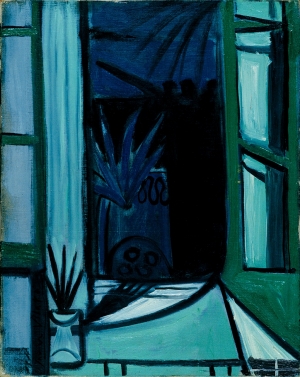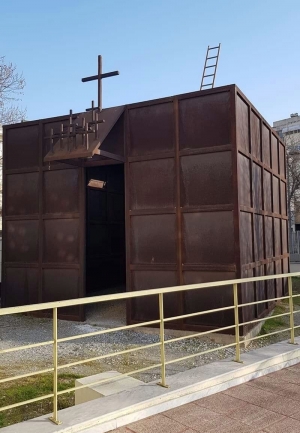cleog
Sunday, 26 April 2020 13:22
[DAY 42] Margarita Lymperaki, Still Life, 1949
Our home, our personal space functions constantly as inspiration for artists. Such an image of memory, escape, loneliness and personal observation is depicted by the writer, Margarita Lymberaki in her artwork Still Life. Few everyday objects placed in space creating a composition realistic and familiar such as the characteristic images that the writer narrates in her literary work, Three Summers (1946): “I remember a few things from our old house. It was somewhere near Lycabettus and had a terrace overlooking Faliro. My father lived with us and we had a greyhound called Dick. I also remember two Chinese vases in the two corners of the hall. Nothing else". [Margarita Lymperaki (1919-2001, Athens), Still Life, 1949 Gouache, 26,4x24 cm Donation of Alexandros and Dorothy Xydis to the Macedonian Museum of Contemporary Art (1999) MOMus - Μουσείο Σύγχρονης Τέχνης / Museum of Contemporary Art-Macedonian Museum of Contemporary Art and State Museum of Contemporary Art Collections]
Published in
MOMus Domus
Tagged under
Saturday, 25 April 2020 19:53
Vilató Javier, Untitled, 1948
The dark room and the night view outside the open window are transformed by Javier Vilató into a setting of dream and fantasy. The artist explored the innovations and upheavals of cubism with traditional representational models close to Uncle Picasso in Paris. The solid contours and the monochrome palette compose the objects, the furniture and space, conveying poetic symbolisms for the human presence or absence. The boundary between the imaginary and the real world is changing, the balance of perspective is lost and space is flowing with the reversal of the meaning inside and outside.
[Vilató Javier (1921-2000, Spain), Untitled, 1948
Oil on canvas, 41x33 cm
Donation of Alexandros and Dorothy Xydis to the Macedonian Museum of Contemporary Art (1999), MOMus - Μουσείο Σύγχρονης Τέχνης / Museum of Contemporary Art-Macedonian Museum of Contemporary Art and State Museum of Contemporary Art Collections]
Published in
MOMus Domus
Tagged under
Saturday, 25 April 2020 19:45
[DAY 40] Achilleas Aperghis, Untitled 1961-62
It wasn’t only the art critic Beatrice Spiliadis who saw the image of "damaged cathedrals" on the sculptures of Achille Aperghis. The sharp forms, the abstract morphology and the strict verticality that characterize many of them, gave rise to similar associations even by the artist himself, while rethinking years later on his artistic work. "It was not possible for the artists to go through the war without any influence in our mental mood and in our aesthetic perception at all," he concludes, commenting on the distinctive artistic universe of the "metallic wear" he created. A world that was methodically built with metallic rods as the raw material which the sculptor processed, welded and composed in such a way as to convey the eerie sense of a corroded and precarious structure.
[Achilleas Aperghis, Untitled 1961-62, 178 x 81 x 35 cm, bronze, Macedonian Museum of Contemporary Art Collection
Donation by Giorgos Aperghis
MOMus - Museum of Contemporary Art-Macedonian Museum of Contemporary Art and State Museum of Contemporary Art Collections]
Published in
MOMus Domus
Tagged under
Saturday, 25 April 2020 19:38
[DAY 39] Dimitris Kozaris, Homes and Spiral Staircases, 2002
Multiple reversals, besides a game of scales at the limits of structure, space and image await the visitor who will finally open the door to the installation of Dimitris Kozaris's "Homes and Spiral Staircases." Scale models of homes that are reminiscent of a diorama disaster or a child's construction pile-ups appear crunched within the dimensions of space which, externally as well as internally seems to be merely "storage" ultimately proves to be enclosing and containing the enormous entity called "home." This upset tends to enhance the imbalance of the leaning homes which, together with their long lost axis have also lost their vital connection with the spiral staircases that used to ensure free movement in addition to maintaining order, connectivity and effective communication.
[Dimitris Kozaris, Homes and Spiral Staircases, 2002
Installation, Dimensions: 220x100x100 cm
Loan by Leonidas Beltsios to the Macedonian Museum of Contemporary Art, MOMus -Museum of Contemporary Art-Macedonian Museum of Contemporary Art and State Museum of Contemporary Art Collections]
Published in
MOMus Domus
Tagged under
Saturday, 25 April 2020 19:35
[DAY 38] Athanasopoulou Lena, Extended Memory I, 2009
Lena Athanasopoulou photographically tests, our memories of landscapes in her Extended Memory series. She sets her lens not on existing landscapes, but on factory manufactured imagery of fairy tale-ish and idealized nature, which she found in one-pound stores around London. And so, landscapes of weirdness, eerie, and magic emerge.
Her intention is to show how different our gaze and memory can be, depending on where, when and how we stand in front of something we miss - even if we have never seen it.
[Athanasopoulou Lena (1979, Greece)
Extended Memory I, 2009
Mixed Media, Archival Inkjet Print 1/3, 68 x 68 cm
Donation of the artist (2010), MOMus - Museum of Contemporary Art-Macedonian Museum of Contemporary Art and State Museum of Contemporary Art Collections]
Published in
MOMus Domus
Tagged under
Saturday, 25 April 2020 19:32
[DAY 37] Alex Mylona, Sun, 1998
Alex Mylona captures the circular shape of the sun in a square frame, in a composition based on the purity of simple geometry. The artist emphasizes on the symbolic dimension of her subject, in order to refer to the concepts of life and birth; at the same time, she refers to her favorite landscape, that of Cyclades. It is the sun that comes to drive away darkness and fear, promising hope for a new day; it is the sun, associated with ancient myths, beliefs and cosmogonies, religious events and philosophical theories, spiritual and artistic pursuits and achievements.
[Alex Mylona, Sun, 1998, Athens, marble, 77 x 77 x 77 cm, MOMus -Museum Alex Mylona]
Published in
MOMus Domus
Tagged under
Saturday, 25 April 2020 19:25
[DAY 36] Katerina Zacharopoulou, Petronella Oortman, 2011
A woman alone in her home, lost in thoughts and memories, surrounded by the objects of everyday life, she thinks, shuffles, is moved, reads, flips through albums with photos, reminisces about the past. Drawing their original reference to the original Petronella Oortman Dollhouse, a 1690 work at the Rijksmuseum in Amsterdam, Katerina Zacharopoulou's performances take place in the rooms of an imaginary house she built herself from a multifaceted ornate set and personal souvenir. Petronella's dollhouse is the ideal representation of the microcosm of a woman living confined to her home space, in another era, when the presence of women in public space was class and socially determined. Everyday activities and experiences are the vehicle that connects today's art with the bourgeoisie of the 17th century, in a visual revision of a hypothetical biography.
[Katerina Zacharopoulou, Petronella Oortman, 2011, performance - video installation,
Reading Room, video still
Waiting Room, video still
MOMus - Museum of Contemporary Art-Macedonian Museum of Contemporary Art and State Museum of Contemporary Art Collections]
Published in
MOMus Domus
Tagged under
Saturday, 25 April 2020 19:22
[DAY 35] Ivan Kliun, “Red Light”, early 1920s
In the early 1920s, Ivan Kliun painted a series of works that he named "Cosmic Images". One of these "images" is the painterly composition "Red light, spherical construction". The painting reflects the attraction of many artists of the Russian Avant-garde for theories on astronomical phenomena, their interest in the future conquest of space and the understanding of the nature of the universe. The light, here, originates from a central source of energy and spreads circularly and intensely on the canvas. The painter uses black oil paints and successive layers of red color and manages to approach his initial purpose, which is to create a kind of self-illuminated painting. Red indicates the color of the revolution, but primarily it signifies the driving force of life.
[Ivan Kliun, “Red Light”, early 1920s, MOMus - Museum of Modern Art-Costakis collection]
Published in
MOMus Domus
Tagged under
Saturday, 25 April 2020 19:18
[DAY 34] Iordanidis, Orthodox Easter, postwar period
An Easter so different from any other, so far away from that in the photograph. A Resurrection that is expected this year, literally as well as metaphorically. So that distances can return to their natural size.
[Socratis Iordanidis, Orthodox Easter, postwar period ©Socratis Iordanidis Archive, MOMus - Thessaloniki Museum of Photography Collection]
Published in
MOMus Domus
Tagged under
Saturday, 25 April 2020 19:15
Stephen Antonakos, Chapel of the Celestial Scale, 1995-99
The Chapel of the Celestial Scale, a large scale artwork by the Greek-American artist Stephen Antonakos, is constructed of rusty iron. Through the opening in its roof, the dark interior is exposed to the elements of nature, rain and wind, but mainly to the sun that on summer days ignites the iron. Antonakos' intention was to create a suffocating atmosphere for the visitor, which, however, finds a "way out" in the view of the staircase that rises above the roof opening and is illuminated with neon ―evoking a spiritual experience, a feeling of exaltation, transcendence and liberation.
[Stephen Antonakos, Chapel of the Celestial Scale, 1995-99, iron, neon, MOMus - Museum of Contemporary Art-Macedonian Museum of Contemporary Art and State Museum of Contemporary Art Collections]
Published in
MOMus Domus
Tagged under



![[DAY 42] Margarita Lymperaki, Still Life, 1949](/media/k2/items/cache/b6d7090a321aeca0f529ab265a288b1b_Generic.jpg?t=20200427_093317)

![[DAY 40] Achilleas Aperghis, Untitled 1961-62](/media/k2/items/cache/725ab2e5536ce3eac0a8dd17d083ff4e_Generic.jpg)
![[DAY 39] Dimitris Kozaris, Homes and Spiral Staircases, 2002](/media/k2/items/cache/f7abac252ae5ed68121b92ba7a669d87_Generic.jpg?t=20200425_164155)
![[DAY 38] Athanasopoulou Lena, Extended Memory I, 2009](/media/k2/items/cache/464131a32be92db1eb03bd70266fdd38_Generic.jpg?t=20200425_163643)
![[DAY 37] Alex Mylona, Sun, 1998](/media/k2/items/cache/a9ccd7cd1c4267a50c67ac0bd7180172_Generic.jpg?t=20200425_163510)
![[DAY 36] Katerina Zacharopoulou, Petronella Oortman, 2011](/media/k2/items/cache/b8cc41f2c23fcd5970f74c3c49efafec_Generic.jpg)
![[DAY 35] Ivan Kliun, “Red Light”, early 1920s](/media/k2/items/cache/7f2cd38b7681e6e2ef83b5a7a5385264_Generic.jpg)
![[DAY 34] Iordanidis, Orthodox Easter, postwar period](/media/k2/items/cache/910084c4eb3461ee8947cd42bdd4b146_Generic.jpg)

